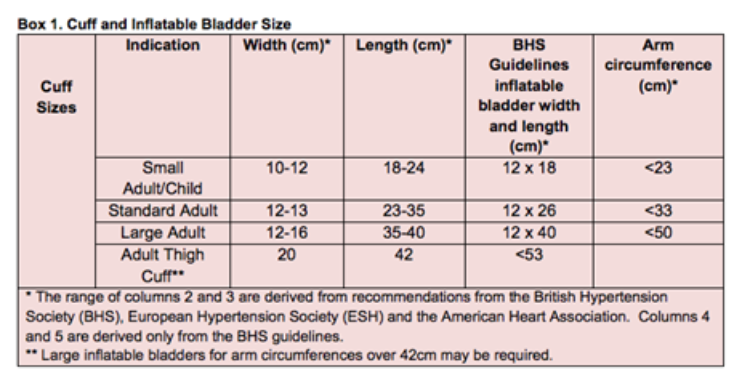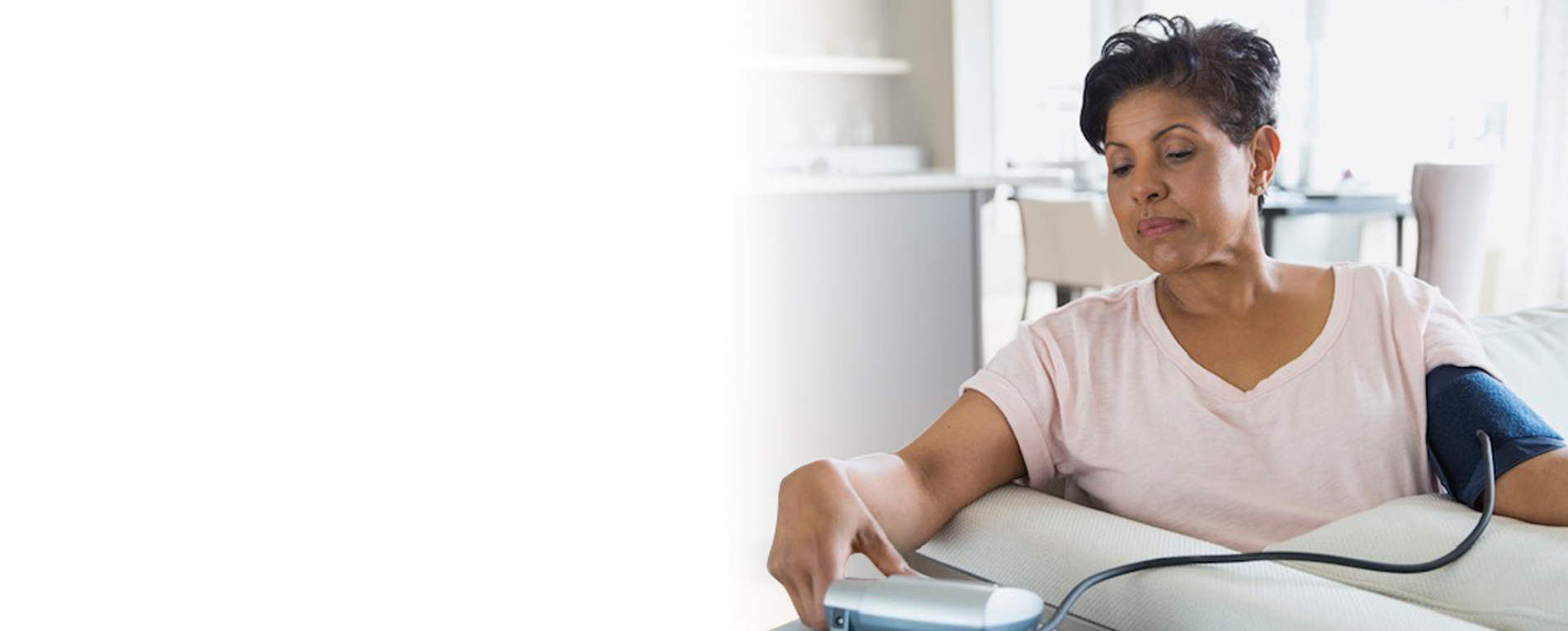Home blood pressure monitoring can be a really useful way of seeing what your blood pressure is like in your daily life.
To make sure you get reliable readings, it’s important to use a monitor that’s suitable for you and that you know how to use it.
Here we explain how home monitoring can be helpful and how to choose a monitor.
We have also created an online resource hub to help you manage and measure your blood pressure at home.
 Home monitoring resource hub
Home monitoring resource hub
Vist the hub to watch our 'how to measure your blood pressure at home' video, read our tips for how to use your home monitor, how to get the most from your monitor and download our home blood pressure monitoring resources.
Why measure your blood pressure at home?
The stress of having your blood pressure measured in clinic can make your blood pressure go up temporarily, so your reading is higher than it should be – this is known as the white coat effect or white coat syndrome.
Coupled with the fact you can only check your blood pressure in a clinic every so often, keeping an eye on your numbers at home can give you and your doctor or nurse a more complete picture of what your blood pressure is like from day to day, and how well your treatments or lifestyle changes are working.
Many people also find that monitoring their blood pressure at home helps them feel more in control, so since 2001, NICE (National Institute of Health and Care Excellence) have recommended GPs offer home blood pressure monitoring.
Home monitoring during coronavirus (COVID-19)
If you monitor your blood pressure at home, keep going as normal, whether that’s once a week or once a month, for example. There is no need to check your blood pressure more often unless your doctor or another health professional has advised you to do so.
If you notice a consistent rise in your blood pressure, contact your GP or practice nurse by phone and they will advise you if you need an appointment. Don’t worry about one-off high readings, it’s normal for your numbers to vary.
If you are looking to buy a home monitor, please see our advice below on how to choose one. You can also read the reasons why home monitoring can be helpful and if it’s right for you in this section, and how and when to measure your blood pressure.
Feel free to contact our blood pressure helpline by email at help@bloodpressureuk.org with questions about home monitoring, your blood pressure and heart health.
While you are at home, if you notice unusual symptoms that you are concerned about do contact your doctor by phone or online, or another NHS service. Always call 999 in an emergency, for example if you think you are having a heart attack or stroke – even if you’re not sure. The NHS would much rather you seek help than go without treatment you need. See the signs of a heart attack and signs of stroke from the NHS.
Make sure you keep taking your blood pressure medicines as prescribed. If you need any advice, pharmacies are open and will be able to support you.
Read more about coronavirus if you have high blood pressure.
If you're lending your monitor to a friend
As viruses can live for some time on plastics and fabrics, you'll need to keep your monitor clean if you lend it to a friend. There is no fixed protocol available, so we've developed these guidelines to help you keep your monitor clean and safe if you are lending it to a friend:
- quarantine your monitor for a minimum of 24 hrs after using it, or
- use a plastic bag or plastic gloves to cover and handle the machine – it will still work through a plastic layer – then throw the plastic away after use.
- Make sure you wash your hands before and after using your machine. If your friend or family member are unable to operate the machine themselves and you check their blood pressure for them, make sure you're both wearing face masks.
Is using a home blood pressure monitor right for you?
Measuring your blood pressure with a home blood pressure monitor can be very useful, but it’s not for everyone. Some people become more anxious when they start measuring at home and end up taking readings too often, this can even temporarily raise your blood pressure.
In our 2016 survey of home monitoring, nine out of 10 (87%) said home monitoring is helpful, reassuring or empowering, while 13% found it caused anxiety.
Before you decide to try monitoring your blood pressure at home, ask yourself: will using a home blood pressure monitor make me feel more relaxed or more worried?
Some health problems may also mean that home monitoring isn’t suitable for you, for example conditions that affect your pulse such as atrial fibrillation. There is also little known about the benefits of home monitoring during pregnancy and for people with vascular problems (conditions which affect the blood vessels). Your doctor will be able to advise you on whether home monitoring is suitable for you.
How to choose the right blood pressure monitor
If you decide to measure your blood pressure at home, you might be given a monitor by the hospital or GP surgery, but you will probably need to buy a home monitor.
There are a wide range of home blood pressure monitors available, which can seem confusing. The most important thing is to make sure it gives you accurate results and is easy to use.
Whatever monitor you choose, make sure that it is:
- clinically validated – this means it has been tested and gives results that you can trust
- automatic (digital) with an upper arm cuff – these are the easiest to use and most reliable
- within your budget – you don’t need to go for an expensive machine, it just needs to be clinically validated and easy to use
Choose a clinically validated monitor
If a machine is clinically validated, this means it has been tested to make sure it gives results that are accurate and reliable, so you and your doctor can trust them.
The British and Irish Hypertension Society have a list of clinically validated home blood pressure monitors on their website.
Choose an automatic blood pressure monitor
There are many different kinds of home blood pressure monitors, but it’s easiest to use a monitor that is fully automatic (digital).
Choose a machine with an upper arm cuff
Choose one that measures your blood pressure at your upper arm, rather than at your wrist or finger, they tend to be more reliable.
Make sure you have the right cuff size
An upper-arm blood pressure monitor will come with a cuff that you wrap around your arm. Make sure you have the right size, otherwise your reading won’t be accurate.
Most home blood pressure monitors will come with a medium-sized cuff, and you might need to order a different-sized cuff separately. To find out what size you need, measure around your arm at the midpoint between your shoulder and elbow, and see where it sits on the chart below. The instructions that come with your monitor will also have information on the cuff size.

Keep your home blood pressure monitor calibrated
Automatic blood pressure monitors need to be re-calibrated at least once every two years – the instructions that come with your monitor will say how often. This is where the monitor is tested and adjusted to make sure it’s giving you accurate results. To have your monitor re-calibrated, you will need to send it back to the manufacturer. There will probably be a fee for this service. Alternatively, you might prefer to buy a new one.
Choose a monitor to suit your budget
Blood pressure monitors vary in price, and there are a number of inexpensive, reliable machines available, starting at about £20. The price usually depends on the number of extra features it has, for example, a built-in memory that stores all your readings.
You don’t need to choose an expensive machine. All you need to measure your blood pressure correctly is a monitor that’s clinically validated, and a pen and paper to record your readings. Extra features can be helpful but they are not necessary, so choose a monitor that you can afford.
Check with a health professional that you know how to use it
All blood pressure monitors come with simple, clear instructions on how to use them, but if you're still not sure then for the first time that you use your blood pressure monitor only, you may like to bring your monitor to your clinic appointment so that your doctor or nurse can check that it’s accurate, the cuff fits, and you know how to use it. They can help you if you’re not sure. You can also watch our video on home blood pressure monitoring.
After the first use of your monitor, you should only call or make an apointment with your nurse or pharmacist for advice if you get variable readings or are still unsure of how to use it.
Where can you buy a blood pressure monitor?
You can buy blood pressure monitors directly from the manufacturer, from many local pharmacies (you may want to get in touch with your pharmacy to ask if they sell blood pressure monitors), from pharmacies such as Boots and Lloyds Pharmacy either online or in large branches, or online from retailers such as Amazon and John Lewis.
The British and Irish Hypertension Society also have a list of clinically validated home blood pressure monitors on their website, as well as a list of monitors for use in clinic.
Blood Pressure UK no longer sell blood pressure monitors and we don't recommend any particular companies or models.
Read more
Learn more about your blood pressure, what blood pressure readings mean, and how to lower your blood pressure.
Read our tips on how to measure your blood pressure at home, or download or order our booklet, Measuring your blood pressure at home.

